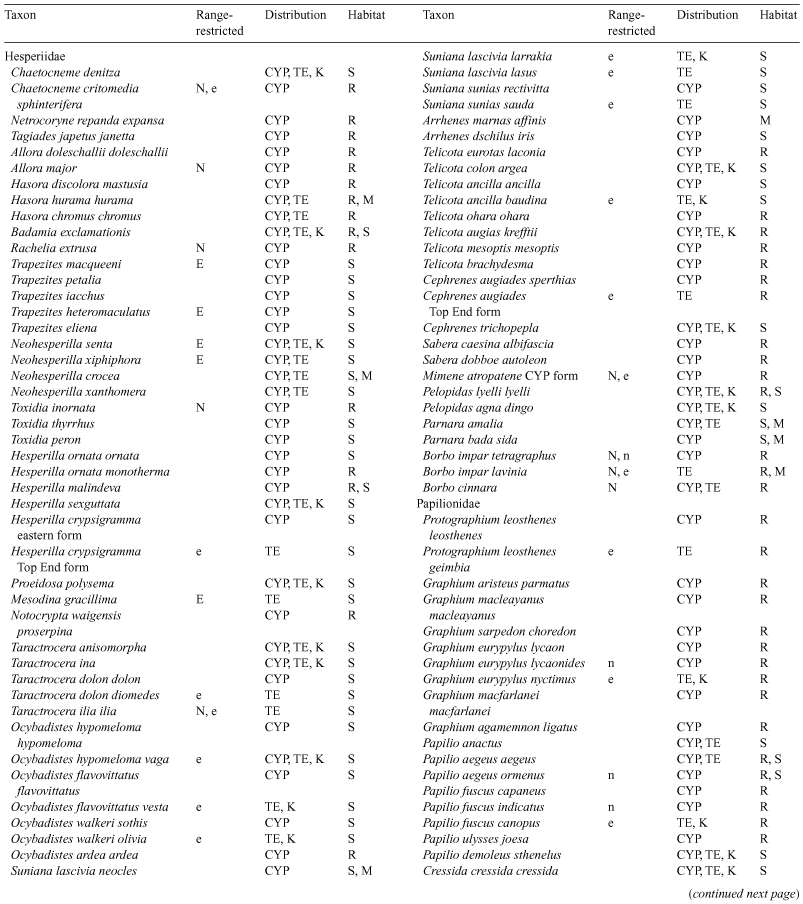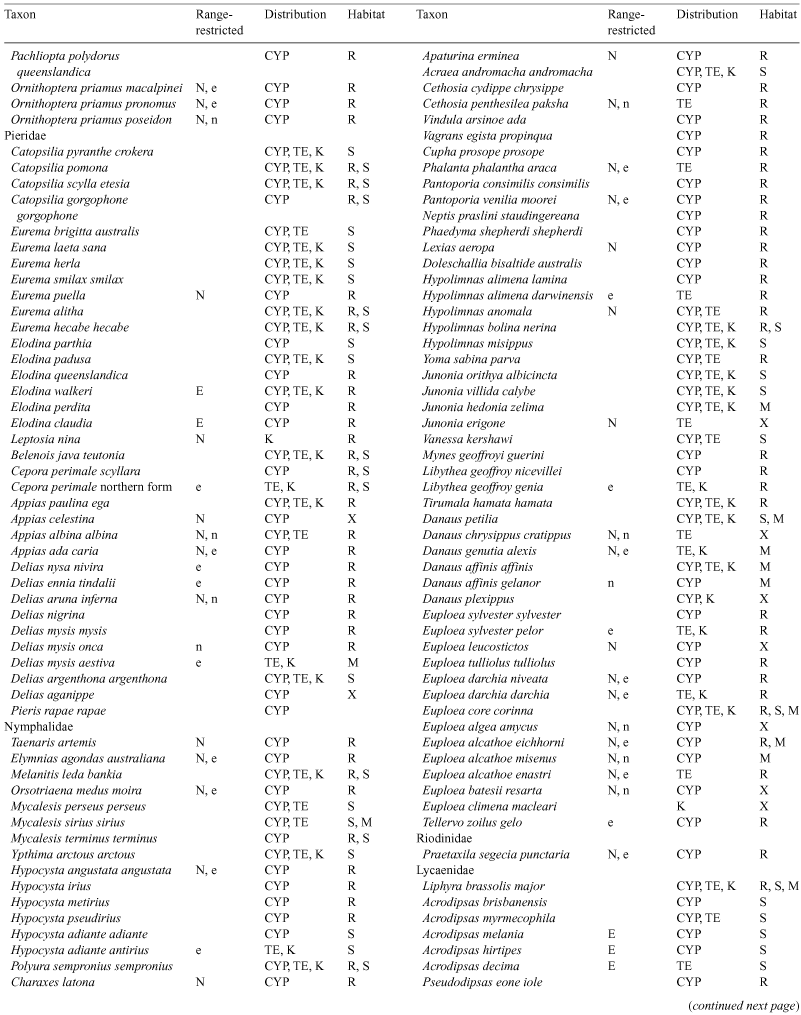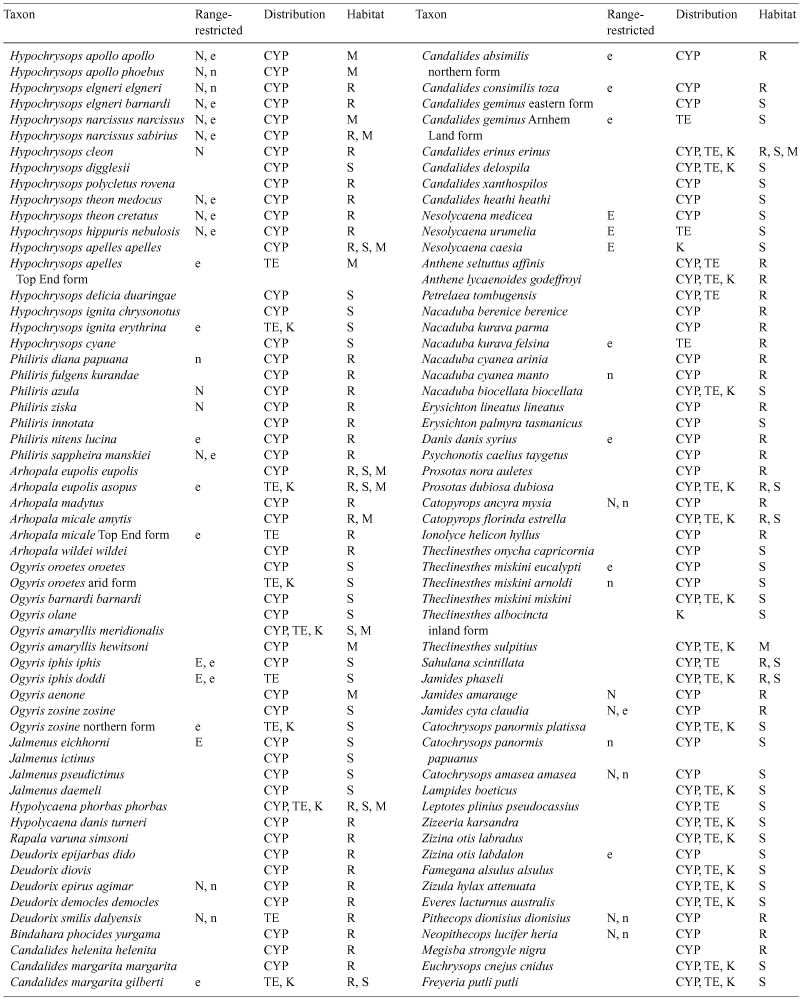Biogeography of butterflies in the Australian monsoon tropics
Michael F. BrabyBiodiversity Conservation Division, Department of Natural Resources, Environment and the Arts, PO Box 496, Palmerston, NT 0831, Australia and School of Botany and Zoology, The Australian National University, Canberra, ACT 0200, Australia. Email: michael.braby@nt.gov.au
Australian Journal of Zoology 56(1) 41-56 https://doi.org/10.1071/ZO08021
Submitted: 29 February 2008 Accepted: 9 July 2008 Published: 14 August 2008
Abstract
The biogeography of butterflies within the monsoon tropical biome of northern Australia is reviewed in terms of patterns of species richness, endemism and area relationships. Available data indicate that the region supports a relatively rich fauna, comprising 265 species (~62% of the total Australian fauna), but endemism is low (6%). No genera are endemic to the monsoon tropics, but two (Neohesperilla, Nesolycaena) are characteristic components, embracing a total of seven species in the region, of which five are endemic. Three ecological specialists (Neohesperilla senta, Elodina walkeri, Candalides delospila), each associated with different vegetation types, appear to be characteristic elements of the monsoon tropics. Of 67 range-restricted species in the monsoon tropics, 15 (mostly associated with savanna) are endemic to the region, while 52 (mostly associated with rainforest) are non-endemic, occurring also in south-east Asia and/or mainland New Guinea. A pronounced attenuation in species richness from Cape York Peninsula across the Top End to the Kimberley is evident. Within the monsoon tropics, Cape York Peninsula stands out as an area of exceptional biodiversity, with 95% of the butterflies (251 species; 7 endemic species, 31 endemic subspecies/geographical forms) recorded from the entire region, compared with the Top End (123 species; 3 endemic species, 17 endemic subspecies/geographical forms). In contrast, the Kimberley has a comparatively depauperate fauna (85 species; 1 endemic species, 0 endemic subspecies) without strong Indonesian affinities, and contains only two range-restricted species. A sister-area relationship between Cape York Peninsula and the Top End–Kimberley is evident in one clade, Acrodipsas hirtipes (northern Cape York Peninsula) + A. decima (Top End), with a pairwise divergence of ~1% based on mtDNA, and is suspected in another, Nesolycaena medicea (southern Cape York Peninsula) and N. urumelia (Top End) + N. caesia (Kimberley); a further five species show similar sister-area relationships across the Carpentarian Gap but at the level of subspecies or geographical form. Three general and complementary hypotheses are proposed to explain patterns of geographical differentiation of butterflies in the monsoon tropics: (1) the Carpentarian Gap is a biogeographical filter, functioning as a barrier for some species but as a bridge for others; (2) divergence among taxa between Cape York Peninsula and the Top End–Kimberley has occurred fairly recently (Quaternary), probably through vicariance; and (3) the Bonaparte Gap, with the exception of Nesolycaena, is not a vicariant barrier for butterflies in the Top End and Kimberley.
Acknowledgements
The ideas presented here arose during a monsoon biogeography workshop held at EcoPoint Murramarang Resort, South Durras, New South Wales, 26–30 November 2007, as part of the ARC Environmental Futures Network project on the Evolutionary history of the Australian biota. I thank the participants for fruitful discussions and Professor D. M. J. S. Bowman and Dr G. Brown for facilitating the meeting. I am also grateful to Dr D. C. Franklin for critically reading the manuscript and helpful suggestions.
Andersen, A. N. , Lowe, L. M. , and Rentz, D. C. F. (2000). The grasshopper (Orthoptera: Acridoidea, Eumastacoidea and Tettigonioidea) fauna of Kakadu National Park in the Australian seasonal tropics: biogeography, habitat associations and functional groups. Australian Journal of Zoology 48, 431–442.
| Crossref | GoogleScholarGoogle Scholar |
Bowman, D. M. J. S. , Braby, M. F. , Brown, G. , Brown, J. , Cook, L. , Crisp, M. D. , Ford, F. , Haberle, S. , Hughes, J. M. , Isagi, Y. , Joseph, L. , Ladiges, P. Y. , McBride, J. , and Nelson, G. (2009). Biogeography of the monsoon tropics: Australia’s last biological frontier. Diversity & Distributions 15,in press
Braby, M. F. (2008). Taxonomic review of Candalides absimilis (C. Felder, 1862) and C. margarita (Semper, 1879) (Lepidoptera: Lycaenidae), with descriptions of two new subspecies. The Beagle. Records of the Museums and Art Galleries of the Northern Territory 24,in press
Crisp, M. D. , Cook, L. G. , and Steane, D. (2004). Radiation of the Australian flora: what can comparisons of molecular phylogenies across multiple taxa tell us about the evolution of diversity in present-day communities? Philosophical Transactions of the Royal Society of London. Series B, Biological Sciences 359, 1551–1571.
| Crossref | GoogleScholarGoogle Scholar | PubMed |
d’Apice, J. W. C. , and Miller, C. G. (1992). The genus Nesolycaena Waterhouse and Turner (Lepidoptera: Lycaenidae) with a description of a new species. Australian Entomological Magazine 19, 75–80.
Edwards, E. D. , Cooney, S. J. N. , Olsen, P. D. , and Garnett, S. (2007). A new species of Trisyntopa Lower (Lepidoptera: Oecophoridae) associated with the nests of the hooded parrot (Psephotus dissimilis, Psittacidae) in the Northern Territory. Australian Journal of Entomology 46, 276–280.
| Crossref | GoogleScholarGoogle Scholar |
Ford, J. (1978). Geographical isolation and morphological and habitat differentiation between birds of the Kimberley and the Northern Territory. Emu 78, 25–35.
Keast, A. (1961). Bird speciation on the Australian continent. Bulletin of the Museum of Comparative Zoology 123, 306–495.
Kikkawa, J. , Webb, L. J. , Dale, M. B. , Monteith, G. B. , Tracey, J. G. , and Williams, W. T. (1981b). Gradients and boundaries of monsoon forests in Australia. Proceedings of the Ecological Society of Australia 11, 39–52.
Koch, L. E. (1957). East Kimberley butterflies. Western Australian Naturalist 11, 83–84.
Meyer, C. E. (1996). A new record of Nesolycaena caesia d’Apice & Miller (Lepidoptera: Lycaenidae) from north-eastern Western Australia. Australian Entomologist 23, 79.
Ozeki, M. , Isagi, Y. , Tsubota, H. , Jacklyn, P. , and Bowman, D. M. J. S. (2007). Phylogeography of an Australian termite, Amitermes laurensis (Isoptera, Termitidae), with special reference to the variety of mound shapes. Molecular Phylogenetics and Evolution 42, 236–247.
| Crossref | GoogleScholarGoogle Scholar | PubMed |
Pierce, F. (2008). Range extensions for various butterflies throughout Australia. Victorian Entomologist 38, 15–16.
Schmidt, D. J. , and Hughes, J. M. (2006). Genetic affinities among subspecies of a widespread Australian lycaenid butterfly, Ogyris amaryllis (Hewitson). Australian Journal of Zoology 54, 429–446.
| Crossref | GoogleScholarGoogle Scholar |
Solem, A. (1984). Camaenid land snails from Western Australia and central Australia (Mollusca: Pulmonata: Camaenidae). IV. Taxa from the Kimberley, Westraltrachia Iredale, 1933 and related genera. Records of the Western Australian Museum 17, 427–705.Supplement
Vane-Wright, R. I. , and Gaonkar, H. (2006). The Arhopala butterflies described by Fabricius: A. centaurus is from Java, A. democritus from Phuket (Lepidoptera: Lycaenidae). Entomological Science 9, 295–311.
| Crossref | GoogleScholarGoogle Scholar |
Weir, R. P. , Meyer, C. E. , and Brown, S. S. (2005). Confirmation of Appias celestina (Boisduval) (Lepidoptera: Pieridae) in Australia. Australian Entomologist 32, 181–182.
Yago, M. , Hirai, N. , Kondo, M. , Tanikawa, T. , Ishi, M. , Wang, M. , Williams, M. C. , and Ueshima, R. (2008). Molecular systematics and biogeography of the genus Zizina (Lepidoptera: Lycaenidae). Zootaxa 1746, 15–38.
and other literature sources (see Methods)


|

|


